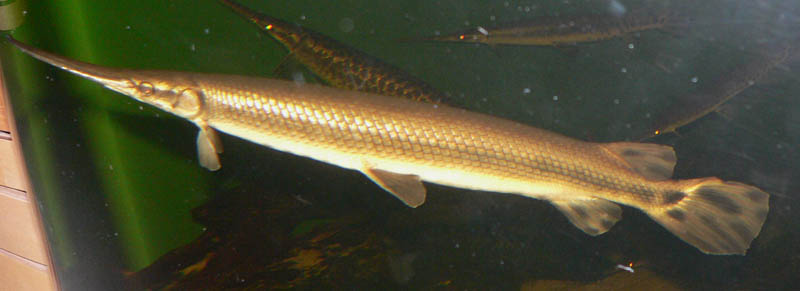Longnose gar
From Wikipedia, the free encyclopedia
[Photo] Photo of Lepisosteus osseus (longnose gar) at the Steinhart Aquarium in San Francisco, taken June 2005 by User:Stan Shebs http://commons.wikimedia.org/wiki/User:Stan_Shebs Date: 6 June 2005
The longnose gar, Lepisosteus osseus, is a species of gar, a type of primitive ray-finned fish. It is also known as the needlenose gar.
Identification
It usually ranges between 30 and 100 cm (24 to 40 inches) and weighs 0.5 to 3.5 kg (1 to 7 pounds); FishBase reports a maximum size of 2 m. The snout is very long and a narrow beak containing many large teeth. Its body is long and cylindrical, covered with diamond-shape scales.
Biology and ecology
Long nose gars usually eat nightcrawlers and other common baits. However the Longnose Gar is also a voracious predator and, when not tempted by baits, is primarily piscivorous in its food choice. The elongate rostrum of the Longnose Gar is used to trick its prey into thinking that it is much smaller than it actually is. To accomplish this, the gar will wait facing the prey head on; the prey sees only the tip of the rostrum and goes to investigate this strange thing, and when it gets close enough, the gar will attack.
It is found usually in backwaters, low inflow pools and clear streams. Longnose gar spawn during early April, in shallow riffle areas. Females are larger than males. They are usually accompanied by one or many males. Nests are never prepared. Each female deposits a portion of her poisonous eggs (or roe) in several different areas. Hatching takes six to eight days.
Distribution
Longnose gar are found in rivers and lakes throughout the eastern half of the United States, as far north as southern Quebec, and as far south as northern Mexico. The most concentrated numbers of longnose gar are found throughout the Deep South, Texas, and anywhere along the Mississippi River.
Fishing
Longnose gar may be captured by entangling the teeth in nylon threads, bowfishing, or by spear fishing.
Longnose gar will also take live baits, but hooking them is problematic. A small circle-style hook should be used, allowing the gar several minutes with it. The circle hook will prevent any serious injury to the gar, as it is designed to catch only in the corner of the mouth. They can be nocturnal feeders in some waters, so anglers should be prepared to angle for them in the twilight.
http://en.wikipedia.org/wiki/Longnose_gar
| The text in this page is based on the copyrighted Wikipedia article shown in above URL. It is used under the GNU Free Documentation License. You may redistribute it, verbatim or modified, providing that you comply with the terms of the GFDL. |
|

